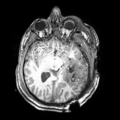Difference between revisions of "2012 Winter Project Week:TBIDTIAnalysis"
From NAMIC Wiki
(Created page with '__NOTOC__ <gallery> Image:PW-SLC2012.png|Projects List Image:MP_RAGE_PRECONTRAST.png|An example T1 weighted image from a patient with TBI…') |
|||
| (2 intermediate revisions by the same user not shown) | |||
| Line 20: | Line 20: | ||
<h3>Objective</h3> | <h3>Objective</h3> | ||
In vivo neuroimaging is an increasingly relevant means for the neurological assessment of traumatic brain injury (TBI). However, standard automated image analysis methods are not sufficiently robust with respect to TBI-related changes in image contrast, brain shape, cranial fractures, white matter fiber alterations, and other signatures of head injury. | In vivo neuroimaging is an increasingly relevant means for the neurological assessment of traumatic brain injury (TBI). However, standard automated image analysis methods are not sufficiently robust with respect to TBI-related changes in image contrast, brain shape, cranial fractures, white matter fiber alterations, and other signatures of head injury. | ||
| − | One of the objectives of the DBP is to develop robust workflows for diffusion weighted imaging (e.g. DTI, HARDI) datasets from TBI patients, by using the NA-MIC Kit and Slicer to obtain reliable and robust metrics of white matter pathology and of white matter changes due to therapy and/or recovery. | + | One of the objectives of the [http://www.na-mic.org/pages/DBP:TBI DBP] is to develop robust workflows for diffusion weighted imaging (e.g. DTI, HARDI) datasets from TBI patients, by using the NA-MIC Kit and Slicer to obtain reliable and robust metrics of white matter pathology and of white matter changes due to therapy and/or recovery. |
</div> | </div> | ||
| Line 26: | Line 26: | ||
<h3>Approach, Plan</h3> | <h3>Approach, Plan</h3> | ||
| − | * | + | *Objective: pairwise DTI registration and DTI analysis on TBI dataset |
| − | **Registration between acute and | + | **Registration between acute baseline and follow-up (only two time points with some deformation due to recovery). |
| − | **Registration to | + | **Registration from subject to atlas (more challenging) |
| − | *Discuss with interested parties to find optimal methods | + | *Discuss with interested parties to find optimal methods handling such large deformations |
| − | * | + | *Perform feasibility test on [[DBP3:UCLA#Results|sample DTI dataset]] |
| + | |||
| + | |||
</div> | </div> | ||
| Line 36: | Line 38: | ||
<h3>Progress</h3> | <h3>Progress</h3> | ||
| − | + | *Discussion with UTAH team | |
| + | *First attempt: use of DTI-Reg to register DTI images - 2 time points between acute baseline and follow-up scan | ||
| + | **ANTS used to drive the registration on skull-stripped FA images | ||
| + | *Data currently being processed | ||
</div> | </div> | ||
Latest revision as of 15:23, 13 January 2012
Home < 2012 Winter Project Week:TBIDTIAnalysisRegistration and analysis of white matter tract changes in TBI
Key Investigators
- UNC: Clement Vachet, Martin Styner
- Utah: Anuja Sharma, Marcel Prastawa, Guido Gerig
- Kitware: Danielle Pace, Stephen Aylward
- UCLA: Andrei Irimia, Jack van Horn
Objective
In vivo neuroimaging is an increasingly relevant means for the neurological assessment of traumatic brain injury (TBI). However, standard automated image analysis methods are not sufficiently robust with respect to TBI-related changes in image contrast, brain shape, cranial fractures, white matter fiber alterations, and other signatures of head injury. One of the objectives of the DBP is to develop robust workflows for diffusion weighted imaging (e.g. DTI, HARDI) datasets from TBI patients, by using the NA-MIC Kit and Slicer to obtain reliable and robust metrics of white matter pathology and of white matter changes due to therapy and/or recovery.
Approach, Plan
- Objective: pairwise DTI registration and DTI analysis on TBI dataset
- Registration between acute baseline and follow-up (only two time points with some deformation due to recovery).
- Registration from subject to atlas (more challenging)
- Discuss with interested parties to find optimal methods handling such large deformations
- Perform feasibility test on sample DTI dataset
Progress
- Discussion with UTAH team
- First attempt: use of DTI-Reg to register DTI images - 2 time points between acute baseline and follow-up scan
- ANTS used to drive the registration on skull-stripped FA images
- Data currently being processed
Delivery Mechanism
This work will be delivered to the NA-MIC Kit as a Slicer extension

